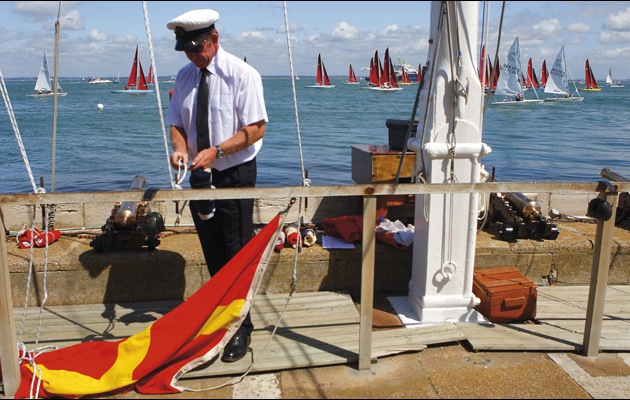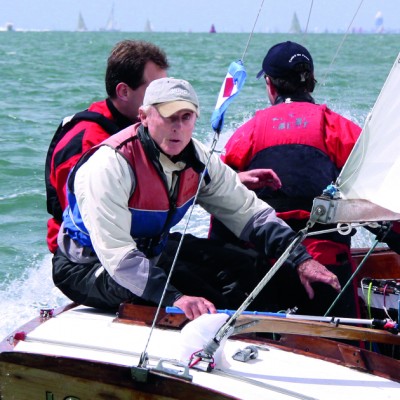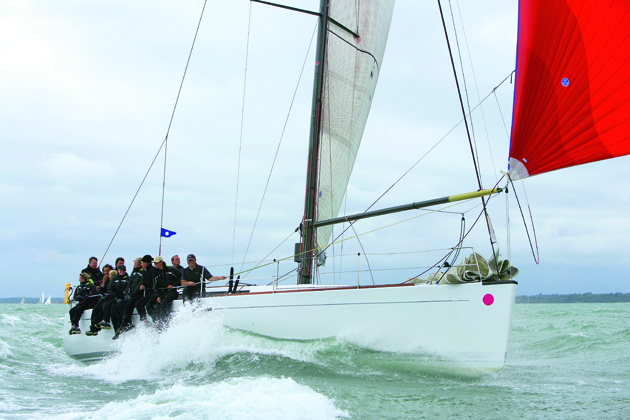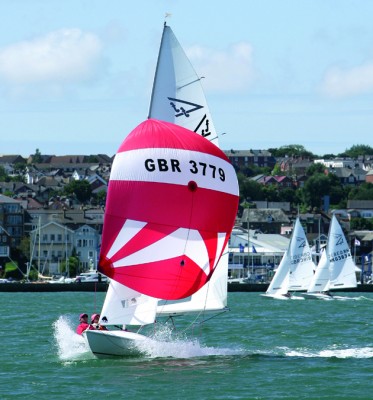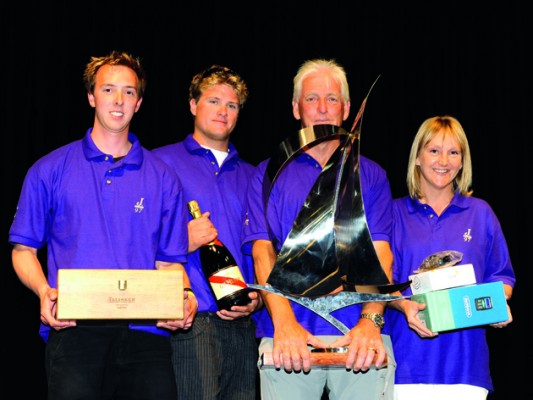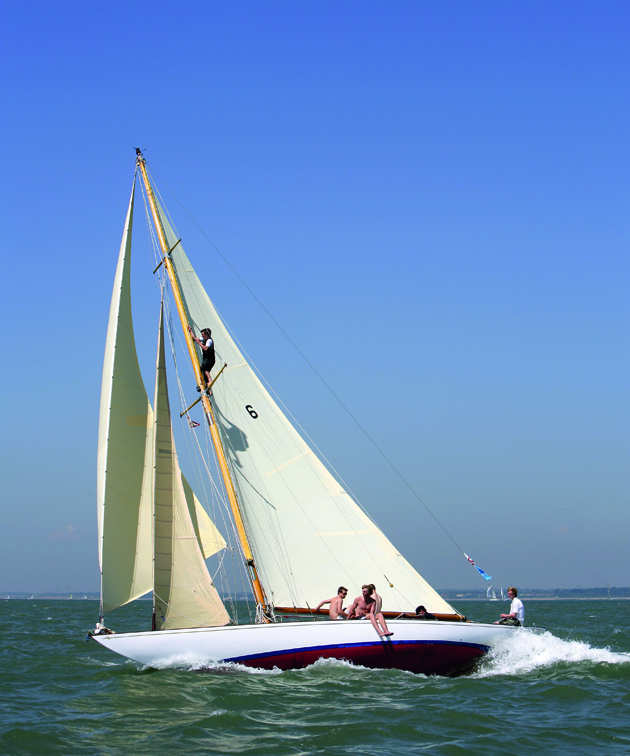With all its complications Cowes Week sometimes feels like a lottery, but it’s revealing that some boats just seem to get lucky year after year! Matthew Sheahan and Jonty Sherwill ferret out tips from past winners
Lone Star – XOD
Name of boat: Lone Star – built 1960 Type of boat: XOD – 119 Owner: Stuart Jardine First Cowes Week: 1956 (won in Persephone XOD 92) 2009 Winner XOD class Scoreline: 1,6,2,1,2,21 Fleet size 80
The XOD is arguably the toughest class to win at Cowes Week with around 80 entries each year. Yet one name has dominated since the mid-1990s.
Stuart Jardine first won the Captain’s Cup in 1956, but a career in the army, plus Olympic Star and J/24 campaigns kept him away for another 40 years. Since 1996 he has won seven more times, and in a class where scorelines read like lottery numbers, it takes more than a quick boat to achieve this level of consistency.
At the age of 77 Jardine is as keen as ever, putting his success down to keeping fit and being well organised: “I just enjoy sailing in big fleets and I enjoy competition, but without the best crew you’ve got no hope. I just sail the boat as fast as I can.”
His crew includes his son Mark, who does tactics, and Christian Brewer who trims the sails and who is particularly talented at setting the small, but awkwardly shaped spinnaker, a sail shape constrained by the original class rules.
Jardine is based at Lymington where 20-25 boats, including one sailed by his twin brother Adrian, regularly turn out for club racing. The class there runs training sessions to improve the performance of all boats in the fleet, thus the competition is fierce – perfect training for Cowes Week.
Jardine believes the standard of XOD competition has improved at Cowes. X119 Lone Star is a 1960 boat built by Burnes, particularly quick upwind in a breeze and twice a previous winner of the Week in the 1960s. There is a variety of builders and hull shapes throughout the fleet, but Jardine feels that overall performance is reasonably level, increasingly so as old boats have been refurbished.
Always with an eye to the future and with no new XOD built for over ten years, Jardine commissioned a strip-plank epoxy boat built to the original class hull lines. Rejected as ‘out of class’ yet apparently no quicker, this boat, which will cost half the price of a traditional XOD, will, he hopes, eventually be accepted by the class.
See our history of the XOD class here
The photo
“This shot was taken near Hill Head buoy on the second beat. The tide was ebbing out of Southampton Water and we were aiming to get into the centre of the channel for maximum benefit. The windward mark must have been West Knoll.
“I’ve always got either the check chart or the Winning Tides book in my hand in the X – I don’t pull any strings apart from the mainsheet round the leeward mark and the kite sheets on drops.
“Every time I see the bow down shot I keep thinking there’s a lift for boats behind and wonder why we’re not on it. I know there isn’t, it just goes through my head!”
Mark Jardine, tactician
Antilope – Grand Soleil 43
Skipper: Willem Wester First Cowes Week: 1998 2009 Winner IRC 2 Scoreline: 1,2,2,1,29,4,1 Fleet size 46
Willem Wester’s success in 2009 didn’t come easily. Just two points separated the top three boats and the final race was a nail-biter, but the Breskens-based team, sailing a production cruiser-racer, beat a more racy-looking King 40 and a Ker 39.
The Grand Soleil might look like a standard production boat, but this one has been breathed on. A development of Roark, the top boat in the 2008 Commodores’ Cup, this Grand Soleil 43OT (open transom), represents the third generation of this popular 43-footer.
“We took a very close look at everything that might make a difference to her performance,” explains Wester. “This boat has a CNC-milled keel, which is both a more accurate shape and a little deeper than the standard keel. It also doesn’t have a bulb, which helps under IRC.
“We have a carbon mast with a jack system, a carbon boom and spinnaker pole and a carbon backstay. Our rudder is also carbon. The rest of the rigging is rod. We also have a hydraulic system for the kicker, backstay and outhaul.
“Our sail wardrobe is North 3DL. During last year’s event the sail that gave us an edge when we needed it was the A3 asymmetric spinnaker, which we used on a long windy reach from Yarmouth back to Cowes. Normally the boat performs better with the symmetrical spinnakers, but on this occasion we were flying along at 15-16 knots all the way and under control.
“We carry four spinnakers, two pairs of light and heavy symmetric and asymmetric kites. Our biggest headsail is a 105 per cent overlapping sail. Under the waterline we’ve blocked off any holes and use hard antifouling as the boat spends a lot of time in the water.”
Yet aside from the close attention to race prep, Wester is a firm believer in teamwork.
“We’ve had the same team for three years and we have a pretty full racing season. Cowes Week is one of the few regattas where you really have to know the tides. The complex manoeuvres that you sometimes have to make as a result demands good crew work. We love it.”
The photo
“This photo was taken on the Friday of Cowes Week 2009 and has the crew on the rail. We are flying a red asymmetric as we come past The Green. It was the last day and the result of this race determined who would win IRC Class 2 overall.
“Basically, the first one in would win. Our main rivals were behind us and many of the crew are looking behind for this reason.
“On the rail from the right is Ged Armitage (dark cap), Daan (light cap), my father Willem (black hat), Pieter, Rebecca Taylor (dark cap), my mother Heleen (facing backwards), Ralph and me.
“On the helm is Marc, to the right of him is Marnix Lippens and to the far right is Philippe. Behind my father and not in view is Seb.”
Minka Ball, crewmember
Men Behaving Badly – Flying Fifteen
Skippers: Rupert and John Maunder First Cowes Week: 1987 2009 Overall Winner White Group Scoreline: 1,1,1,1,1,1,17 Fleet size: 16
A clean sweep of bullets meant that the father and son team of John (67) and Rupert (41) Maunder could take the last day of Cowes Week off and watch the scrap for 2nd place unfold.
But even a string of 1sts doesn’t tell the whole story. Winning White Group for the second time (first in 2004) reveals a consistently good performance over six consecutive Cowes Weeks. Success in 2009 was no accident.
“It’s my son who has the talent in the boat,” John explains modestly. “He was Flying 15 world champion in 1992, and has been inland, northern and southern champion in his time on the circuit. I just sit there and crew.
“But I think what sets Cowes Week apart from other regattas is that the racing is far more like orienteering. The influence of the tides and the navigation places additional demands on a crew.
“The class rules are pretty strict so there’s little in the way of optimisation that you can do for this event. Class rules also prohibit the use of electronic aids apart from a digital compass, so we can’t even use a GPS. This means that you have to have a keen eye for the marks and be on top of judging laylines and transits by eye.”
The Flying 15 fleet has around 15 boats at Cowes, which would normally make for an uncluttered start, but sharing the start line with a similar number of Swallows means the line can get crowded.
“Swallows have a longer waterline length and a lot of sail area so its important to be aware of them as they can blanket you easily.”
This applies elsewhere too.
“In the days when we could run back through the Squadron line to our finish, the run along The Green could get pretty exciting if we became entwined with the Black Group. It’s easy to lose a lot of places and distance in the closing stages of your race if you don’t concentrate on the other classes.”
Jenga V – J /97
IRC Class 5 Skippers: Paul and Marie-Claude Heys First Cowes Week: 1979 2009 Overall Winner Black Group Scoreline: 1,3,1,1,1,1,1 Fleet size: 43
This was the second time UK J Boats agent Paul Heys had won Black Group overall, the first being with the J/109 Waverider in 2002. Considering there were a total of 43 boats in the combined fleet, this was a major achievement.
Being in a large class helped. “The way the overall scoring works means a 1st in a fleet of 30 is more valuable than a win in a smaller fleet,” says Heys. “Then it’s a lucky dip as to how you did compared with the other class winners.”
So first you need to win your class. “Boat preparation has to have started months before,” says Heys. “You need to have sorted the right sail programme and done all you can to ensure the reliability of the boat. You cannot afford to drop results through gear failure.
“My biggest concern last year was waking up one morning during the event to conditions we didn’t have a sail for. To be successful at Cowes Week you have to have the fullest sail inventory the rules will allow. Unlike a spring or winter series, where you sail simpler, shorter courses and where you can take more of a gamble on the weather, at Cowes you have to be able to compete in anything from three to 35 knots.”
Having worked in the industry all his life, Heys is obviously well connected, but any suggestion that his success comes through stacking hotshots aboard his boats is refuted.
“I’ve never aimed to bring on rock stars, although clearly we’re in touch with some good sailors. Last year the only three people to do the entire week were three students from Plymouth University. But they formed the basis of a solid, reliable crew. The three different helmsmen we had during the Week could then concentrate on steering the boat. At Cowes you have to have this. Let others deal with tactics, navigation and other boats.
“We had a new boat, new sails and good people. If you look at the results of other J/97s that have raced since, you’ll see that there’s a good spread of results – some have done well, others not. Success is about the software, not the hardware.”
Solent knowledge is vital: “If ever there was a place where you have to put the hours in it’s here. Then there’s the weather. There’s so much more information available nowadays, especially on the internet, that you have to spend time every day looking at it.
“But overall there’s rarely a surprise result at Cowes Week. There may be a wide variety of conditions thrown at you, but what you’re facing has happened before and it’s remembering the scenario of events and what to do that lies at the heart of success – that and never giving up hope. There are always opportunities to come back.”
The sails for the job
Jenga V’s wardrobe:
Headsails: Code 1,2,3
Heavy weather jib
Spinnakers: 0.5oz, 0.75oz, 0.9oz
“If you were on a stricter budget you’d probably do without the Code 1 headsail and the 0.5oz spinnaker. I guess the sail that did us the most good last year was the reaching (0.75) spinnaker.
“The J/97 is a proven windward/leeward boat, but we didn’t know how she’d fare in the reaching situations. But, when faced with two downwind reaching starts we managed to get our nose ahead on the first leg. Only then was I was more confident that we could compete on the Cowes courses.”
Paul Heys, skipper
Mikado – Fife III 1904
Owner Michael Briggs First Cowes Week: 1999 2009 Winner IRC 6 Scoreline: 2,6,2,9,1,1,1 Fleet size: 38
Sailing a beautiful wooden yacht at Cowes Week takes nerve, but Michael Briggs and his sons race to win aboard the 1904 Clyde Linear 30 Mikado. Winning IRC Class 6 last year in a widely varied fleet of 38 boats was the reward for some ongoing optimisation and clever tactical sailing.
Mikado’s cutaway underwater profile was designed for a gaff mainsail, requiring her to be sailed low and fast. Since the 1920s she has had a bermudan rig, and a new maximum-roach mainsail has now improved her balance.
Briggs and his crew have learned to sail the boat quickly in a breeze by constantly playing this large mainsail – she has no mainsheet winches so one man hauls on the final block on the boom and another tails in the cockpit – but light airs are her best conditions.
The longest, heaviest and deepest boat in her class, Mikado nevertheless has a relatively short mast and long boom, which helps to provide her competitive IRC rating. She also sets an impressive 120m2 (1,300ft2) spinnaker cut to the maximum allowable size.
“We have not done anything radical to her,” says Briggs, “but with a classic boat you have got to take your sails quite seriously. Because Mikado is a classic we don’t use modern sailcloth, and our cream Dacron mainsail we have to renew every three years.
“The first change down from her full cutter rig is to move the inner forestay back to become a babystay – it operates on a Highfield lever – and putting up a deck-sweeping, almost fully battened blade jib. This makes her more close-winded.”
Mikado is also quick on reaching legs, but is at a disadvantage when beating with wind against tide because of her deep draught.
“At the start line it can often pay to take the other end to avoid boats climbing up and over our wind.”
Allowing for age
“You need to find a boat with a reasonably competitive IRC rating. There seems to be no way of guessing which old boats will be competitive – 30-raters like Mikado do well, metre boats don’t. They both have the same overhangs, but the raters are lighter and more easily driven.
“If you have old-fashioned gear your teamwork needs to be really good. Twenty seconds lost getting the spinnaker up will lose a place. Our crew have eight years’ experience.
“In the end, though, good starts, good tide and wind knowledge, and knowing where the humps are on the Beaulieu shore, count the same, whatever the age of the boat.”
Michael Briggs, owner
Yes! – Corby 30
IRC Class 4 Owner: Adam Gosling First Cowes Week: 1994 2009 Winner IRC 4 Scoreline: 2,1,2,1,1,2,13 Fleet size: 42
Adam Gosling, winner of IRC Class 4 in 2009, has raced at every Cowes Week since 1989. In 1996 he won the Etchells World Championship. Yes! is a 30ft John Corby-designed IRC racer built in 1999.
Gosling has sailed with some pros in his time, particularly designer David Howlett, but Cowes is a fun week sailed with his mates, he says. He has won Black Group overall before, in 2005 in a Corby 29, and has had some “remarkable” years aboard a Swan 651, Sydney 60 and Farr 50.
Cowes Week 2009 had too many processional races and in this scenario his opinion is that long waterline length can be a race-winning feature in the IRC classes.
“To win Black Group needs great consistency, the right tools for the job – and your navigation is paramount. Get it right and the Solent is a great place to race, get it wrong and it can bite you!”
The Corby 30, which Gosling bought early in 2009 while recovering from a broken neck – a skiing accident – is less potent in light airs than his Corby 28, but better when the breeze gets up.
He has made no changes this year. “The only thing we have done to the boat since buying her is put some new sails on (now non-overlapping jibs), sorted out the instruments and put the shrouds in the correct place, and corrected a bend in the rudder.”
To win your class you must sail well, says Gosling, but a Cowes Week overall group win is down to luck.
Dauntless – Daring K3 (1961)
Owner: Giles Peckham First Cowes Week: 1980 2009 Winner of Daring class and King of Cowes Scoreline: 2,1,2,1,1,2,3,1 Fleet size: 25
Anyone seeking the ultimate one-design keelboat challenge need look no further than the elegant Daring class. Based on a 5.5-metre design by Arthur Robb, the class numbers 37 and 25-30 turn out each year for Cowes Week.
The class rules require that new sails are purchased as a batch for all boats and scrubbing is done on strict rotation, so the boats are equalised. GPS, echo-sounder and other electronics are banned.
Giles Peckham and his crew sail all the races as a team. His boat Dauntless is the fifth Daring to be rehulled as the fleet is refurbished.
Peckham has sailed in the class for 20 years and he won Cowes Week every year for the five years to 2010. “I always sail with a very competent crew and that’s critical to winning the week,” he says. “The class usually sails three-up, but for Cowes Week it does help to have an extra pair of eyes – and hands.
“The boats are very long and narrow, with very low freeboard, and tend to go through the waves rather than over them. We get green water over the bow and into the cockpit and there is no cuddy – one skill required is bailing!”
Peckham boosted the profile of the Daring class by winning the VW Touareg King of Cowes event in 2008, which was sailed in Laser SB3s in very demanding conditions. For this event he bought an SB3 a few months in advance of the event to “get a bit practice”.
And practice is a key factor in winning, says Peckham. With 55 to 70 club races scheduled each year, Daring sailors get plenty of that.
See also the 10 most common Cowes Week mistakes and how to avoid them!




